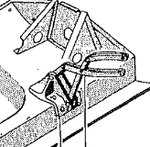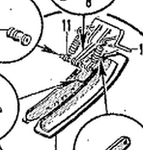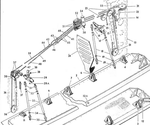Navigation
Install the app
How to install the app on iOS
Follow along with the video below to see how to install our site as a web app on your home screen.
Note: This feature may not be available in some browsers.
More options
You are using an out of date browser. It may not display this or other websites correctly.
You should upgrade or use an alternative browser.
You should upgrade or use an alternative browser.
P-38 vs P-51
- Thread starter jtg
- Start date
Ad: This forum contains affiliate links to products on Amazon and eBay. More information in Terms and rules
More options
Who Replied?pinehilljoe
Staff Sergeant
- 878
- May 1, 2016
Try reading Warren Body's
The Lockheed P-38 Lightning
Warren Body was a contributor to Wings/Airpower magazine, and the book was published with much of the material in a 14 odd part article he wrote in the 70's
The Lockheed P-38 Lightning
Warren Body was a contributor to Wings/Airpower magazine, and the book was published with much of the material in a 14 odd part article he wrote in the 70's
Last edited:
FLYBOYJ
"THE GREAT GAZOO"
Many comparisons have been made between these two great aircraft. Although the thread may be repetitious, maybe we could emphasize on both aircraft without going too far off subject.
swampyankee
Chief Master Sergeant
- 4,166
- Jun 25, 2013
Regardless of anything else, the P-38 was more expensive and required more maintenance for little, if any, performance benefit.
FLYBOYJ
"THE GREAT GAZOO"
Regardless of anything else, the P-38 was more expensive and required more maintenance for little, if any, performance benefit.
True and agree, but that argument is mute when the Mustang has a catastrophic engine failure after taking flack, double the point if over a vast body of water.
GrauGeist
Generalfeldmarschall zur Luftschiff Abteilung
Another advantage of the P-38's, is the concentrated, non-converging firepower at it's nose.
Plenty of strong points on both machines, but also some important 'negatives', especially for P-38. Also, plenty of missed opportunities.
P-51: quick development cycle, good performance even on modest power, excellent performance on good power, almost no 'issues', apart from faulty HMG installantion and, sometimes, not having a positive lock of U/C cover (remedied in winter of 1943/44), long/very long range. Lack of hi-alt performance until Merlin was installed; no drop tank facility early on. Reasonable firepower, if light per UK/Germans standards sometimes.
P-38: long/very long range, good firepower, good performance at all altitudes, ability to carry heavy payload. Problems include protracted development process, lack of second source (granted, not a culprit of a type, but, that coupled with the long development and P-38 being a twin meant that there was a shortcoming of P-38s in 1942-43), big size for a fighter, blind zones for pilot due to booms and nacelles. Problems that were serious, but were rectified by 1944 were low rate of roll, awful heating of cockpit, just one generator, low permissibel dive speed (even with P-38, the P-51 was far better in this regard). Twin engined means twice the engine maintenance and almost twice the fuel needed - not such a factor for CONUS units, but was a thing for units deployed thousands of miles abroad. Twin engine A/C = additional training vs. 1-engine type, not facilitated with complicated layout of handles and switches.
P-51: quick development cycle, good performance even on modest power, excellent performance on good power, almost no 'issues', apart from faulty HMG installantion and, sometimes, not having a positive lock of U/C cover (remedied in winter of 1943/44), long/very long range. Lack of hi-alt performance until Merlin was installed; no drop tank facility early on. Reasonable firepower, if light per UK/Germans standards sometimes.
P-38: long/very long range, good firepower, good performance at all altitudes, ability to carry heavy payload. Problems include protracted development process, lack of second source (granted, not a culprit of a type, but, that coupled with the long development and P-38 being a twin meant that there was a shortcoming of P-38s in 1942-43), big size for a fighter, blind zones for pilot due to booms and nacelles. Problems that were serious, but were rectified by 1944 were low rate of roll, awful heating of cockpit, just one generator, low permissibel dive speed (even with P-38, the P-51 was far better in this regard). Twin engined means twice the engine maintenance and almost twice the fuel needed - not such a factor for CONUS units, but was a thing for units deployed thousands of miles abroad. Twin engine A/C = additional training vs. 1-engine type, not facilitated with complicated layout of handles and switches.
Shortround6
Lieutenant General
The P-38 had a "window" (small) where it was the only game in town for best US fighter. This was from Dec 1941 to the Spring of 1943 when it had to compete with the P-47, which was neither small or cheap/inexpensive. By the fall/winter of 1943 and the coming of the P-51 (and modified P-47s) it was headed for 3rd place and the later tweaks, while quite useful, weren't enough (the other planes were also getting tweaked) to allow it to gain any ground in the race.
It still had some aspects of performance that were 1st rate (and once it got the extra generator the critical engine problem went away) but for return on investment it had been eclipsed.
It still had some aspects of performance that were 1st rate (and once it got the extra generator the critical engine problem went away) but for return on investment it had been eclipsed.
FLYBOYJ
"THE GREAT GAZOO"
Plenty of strong points on both machines, but also some important 'negatives', especially for P-38. Also, plenty of missed opportunities.
P-51: quick development cycle, good performance even on modest power, excellent performance on good power, almost no 'issues', apart from faulty HMG installantion and, sometimes, not having a positive lock of U/C cover (remedied in winter of 1943/44), long/very long range. Lack of hi-alt performance until Merlin was installed; no drop tank facility early on. Reasonable firepower, if light per UK/Germans standards sometimes.
P-38: long/very long range, good firepower, good performance at all altitudes, ability to carry heavy payload. Problems include protracted development process, lack of second source (granted, not a culprit of a type, but, that coupled with the long development and P-38 being a twin meant that there was a shortcoming of P-38s in 1942-43), big size for a fighter, blind zones for pilot due to booms and nacelles. Problems that were serious, but were rectified by 1944 were low rate of roll, awful heating of cockpit, just one generator, low permissibel dive speed (even with P-38, the P-51 was far better in this regard). Twin engined means twice the engine maintenance and almost twice the fuel needed - not such a factor for CONUS units, but was a thing for units deployed thousands of miles abroad. Twin engine A/C = additional training vs. 1-engine type, not facilitated with complicated layout of handles and switches.
Agree with many points - the argument about the placement of handles and switches and complicated layout IMO was probably one of the biggest excuses made for disliking an aircraft. Compare the cockpit of a P-38 to an A-20, B-25, Mosquito and even a Pe-2.
Last edited:
GrauGeist
Generalfeldmarschall zur Luftschiff Abteilung
The Whirlwind had alot going on, too.

FLYBOYJ
"THE GREAT GAZOO"
Of course ignore the portable GPS on the P-38's panel! LOL!
Last edited:
GrauGeist
Generalfeldmarschall zur Luftschiff Abteilung
One of the mistakes I see, when people are saying that the P-51, Spitfire and others are far simpler than the P-38, is that the P-38 is a twin.
So yes, the P-38, Whirlind and others will be more "complex": dual throttles, dual pitch controls, associated gauges and so on!
So yes, the P-38, Whirlind and others will be more "complex": dual throttles, dual pitch controls, associated gauges and so on!
FLYBOYJ
"THE GREAT GAZOO"
Beaufighter

GrauGeist
Generalfeldmarschall zur Luftschiff Abteilung
Kawasaki KI-45

michael rauls
Tech Sergeant
- 1,679
- Jul 15, 2016
One of the advantages of the p38 that I think gets overlooked is that it was very hard to stall. Particularly pertinent in camparison to the p51 which from what ive read anyway had rather nasty stall characteristics.
Looking at it from a what would I want to be flying point of view I would be worried first and foremost about not being a danger to myself more than the enemy and having an aircraft that I can do just about anything in without fear of stalling would be worth quite a bit.
Of course the caviaght here is if one was flying one of the earlier modles of the p38( pre dive flap) one would have to be careful not to exceed the dive speed limits from dives started over 20,000 feet.
Looking at it from a what would I want to be flying point of view I would be worried first and foremost about not being a danger to myself more than the enemy and having an aircraft that I can do just about anything in without fear of stalling would be worth quite a bit.
Of course the caviaght here is if one was flying one of the earlier modles of the p38( pre dive flap) one would have to be careful not to exceed the dive speed limits from dives started over 20,000 feet.
michael rauls
Tech Sergeant
- 1,679
- Jul 15, 2016
That's a tuff call. They are both beautiful aircraft. I suspect that is one of the things that has contributed to the popularity of both.Yes yes, but most importantly, which is sexier?
View attachment 522241Mustang
View attachment 522242DSC_0559
KiwiBiggles
Senior Airman
One of them is all old and wrinkly!Yes yes, but most importantly, which is sexier?
View attachment 522241Mustang
View attachment 522242DSC_0559
MiTasol
Captain
One of the mistakes I see, when people are saying that the P-51, Spitfire and others are far simpler than the P-38, is that the P-38 is a twin.
Sorry, but, as anyone who has worked on them will tell you, the P-38 is excessively complicated and it has nothing to do with having a second engine. It is so bad anyone would think it was British. Actually strike that - it makes British aircraft look quite simple.
This is a main landing gear door hinge - one of five per door so there are 20 per aircraft. What is not shown are the spring and the other casting. etc. Over 40 parts per hinge. The same basic design on the nose gear and gun bay doors.

Showing spring and some other details like the spools

Some detail off the technical drawing ("blueprint")

The main gear and door mechanism is also super-complicated with multiple cylinders (retract, uplock, downlock, door) pulleys, bell-cranks and cables. Lots of high maintenance items - especially when compared to the B-25 where one cylinder opens the main door, retracts the gear and closes both doors and once set up the mechanism is trouble free.
Gear

Doors

GrauGeist
Generalfeldmarschall zur Luftschiff Abteilung
The general consensus (and following conversation) is of the Cockpit arrangement.
It's agreed that the P-38 was complex to maintain, but it was state of the art for it's time and one of the few successful twin fighters of the war.
In regards to the B-25, how did it compare to the A-20, PV-1 or the B-26 - each manufacturer had their own construction criteria and some manufacturers had to work around patents or else pay royalties
It's agreed that the P-38 was complex to maintain, but it was state of the art for it's time and one of the few successful twin fighters of the war.
In regards to the B-25, how did it compare to the A-20, PV-1 or the B-26 - each manufacturer had their own construction criteria and some manufacturers had to work around patents or else pay royalties
Users who are viewing this thread
Total: 1 (members: 0, guests: 1)
Similar threads
- Replies
- 52
- Views
- 4K
